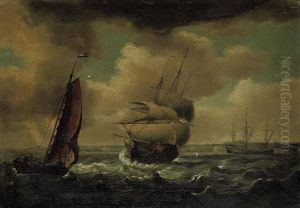G. Bakhuisen Paintings
Ludolf Bakhuizen, often referred to as G. Bakhuisen in various historical documents, was a prominent Dutch painter and printmaker in the 17th century, known for his mastery in marine art. Born in Emden, East Frisia (now Germany) in 1631, Bakhuizen moved to Amsterdam in his early twenties where he initially worked as a calligrapher before fully dedicating himself to painting, drawing, and printmaking. His transition to art was influenced by the vibrant maritime culture of Amsterdam, a leading center of trade and shipping in the 17th century. Bakhuizen's keen interest in the sea and ships, combined with his remarkable talent, positioned him as one of the leading marine artists of his time.
Bakhuizen's art is characterized by its dramatic depiction of the sea, showcasing the turbulent waters of the North Sea, often with Dutch ships battling the elements or engaged in commerce. His works are noted for their dynamic composition, meticulous detail, and the effective use of light and shadow, which lend a sense of movement and realism to his seascapes. Bakhuizen was particularly adept at capturing the intricate rigging of ships and the changing moods of the sea, from calm waters to stormy waves, reflecting his deep understanding of maritime life.
Throughout his career, Bakhuizen enjoyed considerable success and received commissions from wealthy merchants and naval officers, who admired his ability to depict naval glory and the prosperity of the Dutch maritime trade. His works not only serve as historical documents of the Dutch Golden Age’s maritime heritage but also as masterpieces of art that capture the eternal struggle and beauty of man's interaction with the sea.
Bakhuizen's influence extended beyond his own paintings and prints; he taught and inspired a generation of artists, contributing to the enduring legacy of Dutch marine painting. His works are preserved in major museums around the world, where they continue to be celebrated for their technical brilliance and evocative power. Ludolf Bakhuizen passed away in Amsterdam in 1708, leaving behind a rich legacy that secures his place among the pantheon of great maritime artists.
